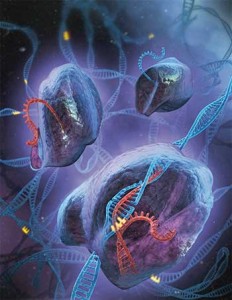A new photoactivatable CRISPR/Cas9 engineered

 The genome editing tool CRISPR/Cas has been engineered in many different ways since it first appeared. The last innovation comes from the University of Tokyo, where the group lead by Dr. Moritoshi Sato has created a photoactivatable CRISPR/Cas9. Genome edition can now be more precisely directed, in time and space: a ray of light can switch on and off the system. The finding has been published in Nature.
The genome editing tool CRISPR/Cas has been engineered in many different ways since it first appeared. The last innovation comes from the University of Tokyo, where the group lead by Dr. Moritoshi Sato has created a photoactivatable CRISPR/Cas9. Genome edition can now be more precisely directed, in time and space: a ray of light can switch on and off the system. The finding has been published in Nature.
Dr. Sato had previously bioengineered what the called Magnet proteins. He worked with a fungal photoreceptor protein, Vivid. Dr. Sato and his team separated the protein in two domains that only came together -via electrostatic interactions- when illuminated. The domains were furthermore designed to be unable to homodimerize. The two domains, which he called “pair of Magnet proteins”, could then be fused to proteins of interest that would come together only when photoactivated. Many molecular processes in the cell can be optogenetically manipulated with the designed photoswitches.
In his last project, Dr. Sato took advantage of the Magnet proteins to refine genome editing control. He designed two chimeric, inactive proteins that consisted each of one Magnet and half Cas9. When illuminated with blue light, the two magnets come together and bring the two Cas9 halfs into close proximity. Cas9 reconstitutes as an active nuclease and proceeds to cut the DNA in the illuminated spot, at the desired time point.
It is not clear yet whether this new system will reduce CRISPR off-target effects, but it is possible that limiting the time it remains active will contribute to it.
Sources:
http://www.nature.com/nbt/journal/vaop/ncurrent/full/nbt.3245.html
http://www.nature.com/ncomms/2015/150224/ncomms7256/full/ncomms7256.html
http://www.the-scientist.com/?articles.view/articleNo/43255/title/Optogenetics-Meets-CRISPR/
